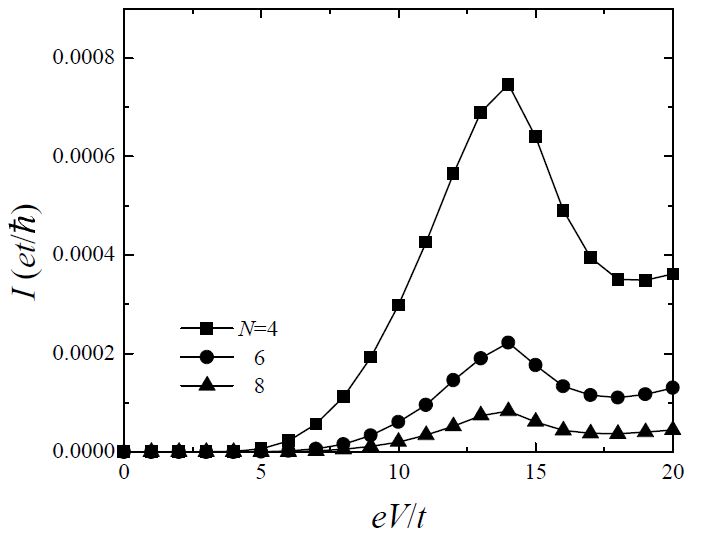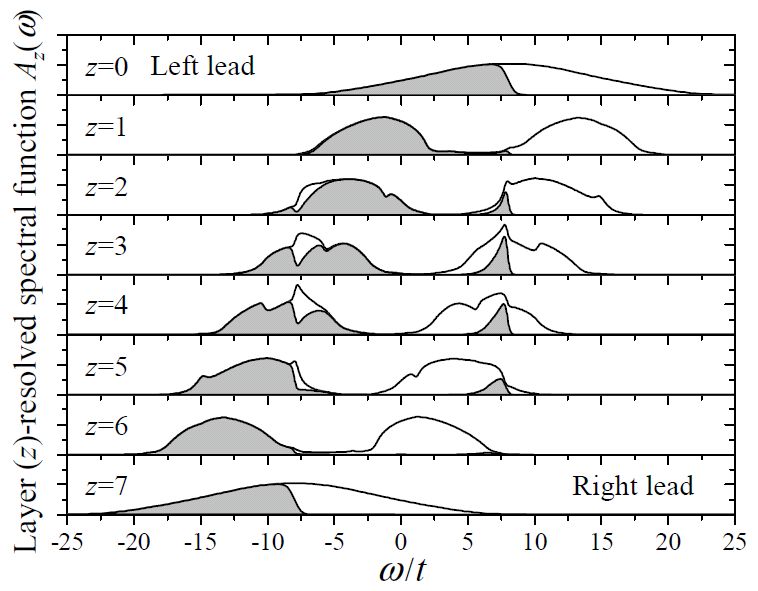Transport in correlated electron systems
Study of the transport properties of heterojunctions consisting of correlated-electron systems
is of primary importance for fundamental science and device engineering.
Understanding of this problem will lead us to the realization of electronic devices utilizing
the novel properties of correlated-electron materials,
including for example tunneling magnetoresistance (TMR) junctions involving colossal magnetoresistance manganites
and Josephson junctions involving high Tc cuprates.
We apply modern many-body techniques such as time-dependent DMRG and nonequilibrium DMFT.
Properties are highly dependent on the interface condition and, thus, on the electronic state.
This area of research is closely related to the previous description of electronic reconstruction
that may appear at interfaces.
Recently, we have applied DMFT combined with Keldysh Green's function technique to study the transport
and optical properties of model junctions consisting of metallic leads and a Mott insulator
[S. Okamoto, Phys. Rev. B 76, No. 3, 035105 (2007)].
Current vs voltage characteristic was found to be quite similar to that of conventional junctions involving a band insulator.
While, applied bias voltage was found to deform the spectral functions of correlated electrons significantly.
Similar current vs voltage characteristic was also obtained for one-dimensional correlated junctions
using time-dependent DMRG technique.
 Current vs voltage characteristics of Hubbard heterostructures with thickness of interacting layers
N = 4, 6, and 8, and with on-site interaction U = 15t with t hopping intensity.
Current vs voltage characteristics of Hubbard heterostructures with thickness of interacting layers
N = 4, 6, and 8, and with on-site interaction U = 15t with t hopping intensity.
|
 Layer (z)-resolved spectral function of the N = 6 Hubbard heterostructure with U = 15t.
The filled area shows the region occupied by electrons.
Layers at z = 0 and 7 correspond to the Left and Right leads, respectively.
Chemical potential of the Left leads is εL = 8t,
which is higher than that of the Right leads εR = -8t (bias voltage eV = 16t).
Thus, current flows from top (Left leads) to bottom (Right leads) though the interacting layers at 1 < z < 6.
Spectral functions in the interacting region are deformed by the injected carriers from the two leads.
Layer (z)-resolved spectral function of the N = 6 Hubbard heterostructure with U = 15t.
The filled area shows the region occupied by electrons.
Layers at z = 0 and 7 correspond to the Left and Right leads, respectively.
Chemical potential of the Left leads is εL = 8t,
which is higher than that of the Right leads εR = -8t (bias voltage eV = 16t).
Thus, current flows from top (Left leads) to bottom (Right leads) though the interacting layers at 1 < z < 6.
Spectral functions in the interacting region are deformed by the injected carriers from the two leads.
|
 Current vs voltage characteristics of Hubbard heterostructures with thickness of interacting layers
N = 4, 6, and 8, and with on-site interaction U = 15t with t hopping intensity.
Current vs voltage characteristics of Hubbard heterostructures with thickness of interacting layers
N = 4, 6, and 8, and with on-site interaction U = 15t with t hopping intensity.
 Layer (z)-resolved spectral function of the N = 6 Hubbard heterostructure with U = 15t.
The filled area shows the region occupied by electrons.
Layers at z = 0 and 7 correspond to the Left and Right leads, respectively.
Chemical potential of the Left leads is εL = 8t,
which is higher than that of the Right leads εR = -8t (bias voltage eV = 16t).
Thus, current flows from top (Left leads) to bottom (Right leads) though the interacting layers at 1 < z < 6.
Spectral functions in the interacting region are deformed by the injected carriers from the two leads.
Layer (z)-resolved spectral function of the N = 6 Hubbard heterostructure with U = 15t.
The filled area shows the region occupied by electrons.
Layers at z = 0 and 7 correspond to the Left and Right leads, respectively.
Chemical potential of the Left leads is εL = 8t,
which is higher than that of the Right leads εR = -8t (bias voltage eV = 16t).
Thus, current flows from top (Left leads) to bottom (Right leads) though the interacting layers at 1 < z < 6.
Spectral functions in the interacting region are deformed by the injected carriers from the two leads.